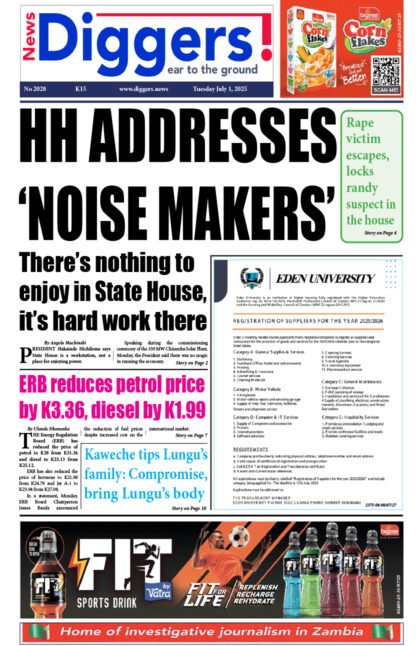BANK of Zambia (BoZ) governor Christopher Mvunga says Zambia’s international gross reserves have plummeted to an unprecedented US$1.2 billion by the end of last year, representing 2.4 months of import cover, from US $1.3 billion three months prior, the lowest ever in the country’s history.
And Mvunga has explained that the decision to hike the Monetary Policy Rate (MPR) by 50 basis points to 8.5 per cent will not have a significant impact on the country’s liquidity.
Speaking during the MPR announcement in Lusaka, Wednesday, Mvunga disclosed that the drastic drop in the country’s dwindling reserves was largely triggered by government’s ongoing external debt servicing.
International reserves are any kind of reserve funds, which central banks can pass among themselves, internationally, and they remain an acceptable form of payment among these banks.
“Gross international reserves declined by US $117 million to US $1.2 billion, equivalent to 2.4 months of import cover, at end-December, 2020, from US $1.3 billion at end-September, equivalent to 2.3 months import cover. The decline was largely on account of foreign exchange interventions and debt service, which Bank of Zambia had to undertake. I have just mentioned to you that we actually sold into the market US $340 million in the last quarter compared to US $148 million the previous quarter. So, that’s why you are seeing that, that’s partially why the decline is being explained. I should also hasten to say that we are quite optimistic to say that with the bouncing back of the copper prices, we should have some respite in terms of how much forex (foreign exchange) will be coming in,” Mvunga told journalists at the central bank.
He added that despite the country recording high copper exports, it did not directly impact the exchange rate as mining companies usually opted to keep their money in offshore accounts.
“Exports rose by 2.7 per cent to K2.4 billion supported by copper export earnings that rose on account of higher average realised prices and volumes. I think one of the questions that you probably want to ask me is, if the exports are higher, why is the exchange rate suffering? I think just to pre-empt that question, if you look at the way the mining industry operates, whilst we capture the exports on the Balance of Payment (BoP) account, it doesn’t necessarily mean that the copper is sold in dollars. The mining companies have got accounts offshore, so it doesn’t necessarily translate into that money physically coming back into the country. They do transfer money back into the country in a need basis as their expenditure demands emerge. So, you won’t have a direct correlation, which says, ‘because we made X amount of money, it means that money automatically came back into the country and it impacted the exchange rate’,” he explained.
And Mvunga justified the Monetary Policy Committee’s (MPC) decision to hike the benchmark Policy Rate to 8.5 per cent as a move to create a balance between focusing on economic growth and tackling surging inflation, which hit 21.5 per cent last month.
“So, what’s happening is that we are caught in an environment where inflation is running off and the more liquidity you add into the market, you can actually make the situation worse and at the same time, the Bank is very clear and very alive to the fact that the economy has been contracting and that’s what I was saying, so you need to get this balance right between do we focus on economic growth and recovery and leave inflation on its own, or do we try and get to a balance? So, the Monetary Policy Committee has looked at all these things and what we felt is that there are enough instruments that will safeguard against the high cost of borrowing because your direct translation of the 50 basis points will be transmitted into the credit system,” he said.
“You will realise that we have still got facilities like the targeted Medium Term Refinancing Facility, the K10 billion, of which we have disbursed close to K4.1 billion so there is a significant uptake getting on from there. You also realise that on this facility, it’s ring-fenced in terms of pricing. So, all the disbursements that have happened in the past, we won’t reprice them, they will still be kept at eight percent, only the new disbursements will go at 8.5 per cent,” he said.
He added that the central bank remained confident that some of the Monetary Policy instruments that were already in place will mitigate the rise in the higher MPR in terms of starving off credit from the market.
He further added that despite the rise in the MPR, the central bank was equally confident that there will be sufficient liquidity on the financial market.
“From a liquidity point of view, our assessment is that there shouldn’t be a severe (contraction)…Yes, there will be an impact, but it shouldn’t be significant, it shouldn’t be pervasive to the extent where it will stifle the economy. So, we have done all these stress tests and analysis and we feel comfortable that there will be sufficient liquidity even with the 50 basis points increment,” said Mvunga.
According to BoZ data, Zambia’s reserves of just US $1.2 billion by the end of the fourth quarter of last year are the lowest-ever on record.
The country’s reserves have drastically dwindled since 2016 precisely in tandem with Zambia’s escalating external debt stock and correspondingly high debt servicing, which puts tremendous pressure on the reserves.
The last time the country’s international gross reserves dropped to below US $2 billion before 2016 was in 2009 when BoZ data revealed that reserves held were at US $1.9 billion in December of that year.
Zambia’s reserves peaked at over US $3.9 billion in July, 2015.



















